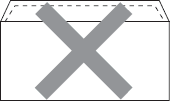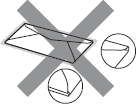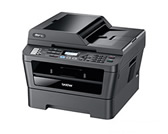MFC-7860DW
FAQs & Troubleshooting |
What is the recommended paper?
This machine can use recycled paper that meets DIN 19309 specifications.
| Basis weight | 75-90 g/m2 (20-24 lb) |
| Thickness | 80-110 μm |
| Roughness | Higher than 20 sec. |
| Stiffness | 90-150 cm3/100 |
| Grain direction | Long grain paper with a neutral Ph value, and a moisture content of approx. 5% |
| Volume resistivity | 10e9-10e11 ohm |
| Surface resistivity | 10e9-10e12 ohm-cm |
| Filler | CaCO3 (Neutral) |
| Ash content | Below 23 wt% |
| Brightness | HIGHER Than 80% |
| Opacity | HIGHER than 85% |
- DO NOT put different types of paper in the paper tray at the same time because it may cause paper jams or misfeeds.
- For proper printing, you must choose the same paper size from your software application as the paper in the tray.
- Avoid touching the printed surface of the paper immediately after printing.
- Before you buy a lot of paper, test a small quantity to make sure that the paper is suitable.
For users in US/ Canada/ Latin America/ Europe region only:
We recommend the following paper types for this machine.
|
Paper Type |
Europe |
USA |
| Plain paper |
Xerox Premier TCF 80 g/m2 |
Xerox 4200DP 20 lb |
| Recycled paper | Xerox Recycled Supreme 80 g/m2 | (No specific brand recommended) |
| Labels | Avery laser label L7163* | Avery laser labels white #5160 |
| Envelope | Antalis River series (DL) | (No specific brand recommended) |
* Label Specifications
The machine will print on most types of labels designed for use with a laser machine. Labels should have an adhesive that is acrylic-based since this material is more stable at the high temperatures in the fuser unit.
Adhesives should not come in contact with any part of the machine, because the label stock may stick to the drum unit or rollers and cause jams and print quality problems. No adhesive should be exposed between the labels. Labels should be arranged so that they cover the entire length and width of the sheet. Using labels with spaces may result in labels peeling off and causing serious jams or print problems.
All labels used in this machine must be able to withstand a temperature of 200 degrees centigrade (392 degrees Fahrenheit) for a period of 0.1 seconds.
Do Not use the following type of paper, envelopes and labels.
Some types of paper may not perform well or may cause damage to your machine.
- DO NOT use inkjet paper because it may cause a paper jam or damage your machine.
- Preprinted paper must use ink that can withstand the temperature of the machine's fusing process 200 degrees centigrade (392 degrees Fahrenheit).
- If you use bond paper, paper having a rough surface or paper that is wrinkled or creased, the paper may exhibit degraded performance.
- DO NOT use paper:
- that is highly textured
- that is extremely smooth or shiny
- that is curled or warped
* 1 A curl of 2 mm (0.08 in.) or greater may cause jams to occur.

- that is coated or has a chemical finish
- that is damaged, creased or folded
- that exceeds the recommended weight specification in this guide
- with tabs and staples
- with letterheads using low temperature dyes or thermography
- that is multipart or carbonless
- that is designed for inkjet printing
If you use any of the types of paper listed above, they may damage your machine. This damage is not covered under any Brother warranty or service agreement.
- DO NOT use envelopes:
- that are damaged, curled, wrinkled, irregularly shaped, extremely shiny or textured envelopes.
- with clasps, staples, snaps, tie strings, self-adhesive components, windows, holes, cutouts or perforations.
- that are of a baggy construction, not sharply creased, embossed (have raised writing on them) or preprinted on the inside.
- that were previously printed by a laser / LED printer.
- that cannot be arranged when put in a pile.
- that are made of paper that weighs more than the paper weight specifications for the machine.
- with edges that are not straight or consistently square.
- with glue on surface as shown in figure below

- with double flaps as shown in figure below

- with sealing flaps that are not folded down when purchased
- with sealing flaps as shown in figure below

- with each side folded as shown in figure below

- DO NOT use labels:
that are damaged, curled, wrinkled or an unusual shape

- Avoid feeding labels with the carrier sheet exposed because your machine will be damaged.
- Label sheets should not exceed the paper weight specifications above. Labels exceeding this specification may not feed or print properly and may cause damage to your machine.
- Do not reuse or insert labels that have previously been used or are missing a few labels on the sheet.
Related Models
DCP-7055, DCP-7060D, DCP-7065DN, DCP-8110D, DCP-8155DN, FAX-2840, FAX-2950, HL-2130, HL-2132, HL-2135W, HL-2220, HL-2240D, HL-2242D, HL-2250DN, HL-2270DW, HL-5440D, HL-5450DN, HL-5470DW, HL-6180DW, MFC-7240, MFC-7290, MFC-7360, MFC-7360N, MFC-7362N, MFC-7460DN, MFC-7470D, MFC-7860DN, MFC-7860DW, MFC-8510DN, MFC-8910DW, MFC-8950DW
